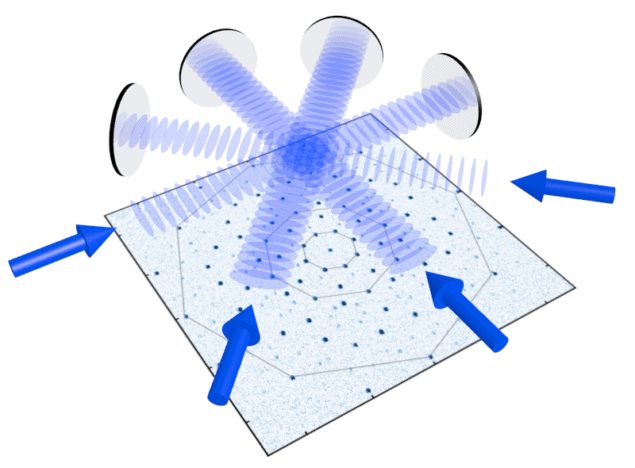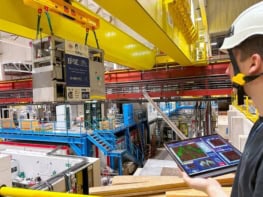
A Bose–Einstein condensate (BEC) of ultracold atoms has been created on a 2D quasicrystalline optical lattice by Ulrich Schneider and colleagues at the University of Cambridge in the UK. The pioneering study could pave the way for quantum many-body simulations in fractal systems and systems with higher dimensions.
Quasicrystals are materials with structures that are not periodic in space but have some long-range order. Quasicrystals have the fractal quality of self-similarity and can be related to crystals that exist in higher dimensions.
Optical lattices are created using standing waves of laser light that trap atoms at regular intervals. Physicists have already studied ultracold atomic gases within optical quasicrystals that were created by overlapping two or more optical lattices with different lattice spacings.
Unwanted scattering
One of the main goals of these studies has been to simulate the behaviours of quantum many-body systems within quasicrystals, and potentially, in higher dimensions. So far, however, these efforts have been hindered by laser-induced resonances in some of the trapped atoms, which scatter the laser light in unwanted directions.
In their study, Schneider’s team formed an optical lattice from a planar arrangement of four intercepting 1D optical lattices, separated by a 45° angle. They then fine-tuned each lattice to create a quasicrystal with eightfold rotational symmetry. By tuning their optical lattice far from the resonant frequency of the atoms, they could ensure minimal unwanted scattering.
Their experiments began with a pre-formed BEC composed of potassium atoms that is created in the absence of an optical quasicrystal. Then, the optical lattices were switched on in a pulse lasting few microseconds – creating the quasicrystal.
Forbidden momentum
Schneider and colleagues found that during the brief time their quasicrystal was turned on, atoms in the BEC scattered photons from one beam to another. This put the atoms in distinctive, time-varying series of momentum states. While lower momentum states are forbidden for atoms in periodic lattices, those in the researchers’ quasicrystal-like BEC moved to successively lower, and more closely-spaced momentum states through a series of small photon-induced velocity boosts.

Superconductivity spotted in a quasicrystal
The physicists say that this behaviour constitutes a “quantum walk” in their quasicrystal’s momentum space, resulting in a diffraction pattern that appeared as an infinite series of progressively larger octagons. This is similar to the discovery of quasicrystals by Dan Shechtman and colleagues in 1984, who observed electron diffraction patterns that displayed rotational symmetries beyond the two- three- and six-fold symmetries allowed in periodic crystals.
From their observations, Schneider’s team interpreted their 2D quasicrystal as a projection of a 4D lattice onto a 2D plane, demonstrating the possibility of simulating higher dimensions with quasicrystal-like optical lattices. Their work could soon allow for controllable simulations of quantum many-body systems over a wide range of new quasicrystal environments; potentially allowing for explorations of exotic new 4D phenomena.
The research is described in Physical Review Letters.



